Brioche Bread
Posted: July 10, 2023 · Modified September 19, 2023 by Cindy Gibbs
This Brioche Bread is rich, buttery, and eggy and the perfect bread for French toast or bread pudding recipes. This recipe makes two loaves, so freeze one for later. It’s a perfect bread to freeze in advance for a holiday breakfast or brunch recipe.
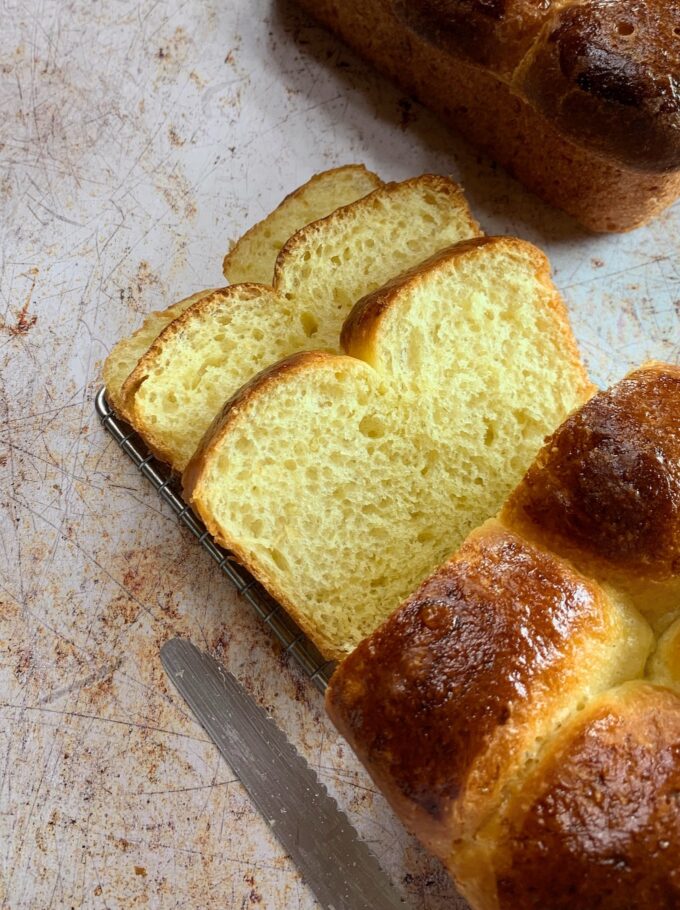
Learn how to make homemade Brioche Bread with this easy step-by-step recipe. You’ll be SO glad you did.
What is Brioche Bread?
Brioche bread is a french bread and it’s considered to be a Viennoiserie. This means while it’s technically bread, it has the characteristics of a pastry since the dough is enriched with butter and eggs, which lead to a rich and tender crumb.
You can eat this buttery bread by itself, with jam spread over it, toasted, or use it to make french toast, bread pudding, and other recipes. It freezes beautifully, so place some loaves in your freezer to save for your favorite holiday recipes.
Once I made this rich buttery bread, I felt I had to share it with everyone. It calls for yeast, but please don’t let the word yeast scare you. You’ll find just how easy it really is to work with yeast.
Please read all the steps in this post before making the recipe. It will help you to better understand the recipe and will help you to make perfect bread!
Are you ready? I’m about to walk you through this recipe one easy step at a time!
Day One – Making the dough!
- Preheat the oven to 160 degrees and turn it off. Generously butter a large bowl and set aside.
- Proof the yeast: In a measuring cup, add the yeast to the lukewarm milk and let proof for 5 minutes. I use a spoon to push the dry yeast down into the milk so that all of it gets wet. Set this aside while starting the next step.
- Add the eggs to the bowl of a stand mixer fitted with the dough hook. Mix the eggs for a few seconds to break them up. Add the flour, salt, and yeast mixture. Mix on low speed for 5 minutes to combine and start kneading. Turn the mixer to medium speed and continue to knead until the dough is smooth and elastic about 10 minutes.
- In a separate bowl, mix the sugar into the butter, combining well. Drop a few pieces of the butter mixture into the bowl, while mixing on low speed. Continue adding the butter mixture a little bit at a time, mixing on low speed until all of the butter has been incorporated. Don’t drop too much butter in at a time. It takes a little while for the butter (fat) to be incorporated into the flour & egg.
- Once the butter is totally incorporated, increase the mixer to medium speed and knead the dough for about 6 to 8 more minutes. The dough should be shiny, smooth, and elastic, and it should easily pull away from the sides of the bowl. It will also be pretty thin, almost like pancake batter. (see the photo below step 6).
- Using a spatula, transfer the dough to the prepared (buttered) bowl. Lightly spray a piece of plastic wrap and place it over the top, sealing it tightly.

Letting The Dough Rise (day one, first rise)
- Place the bowl in the slightly warm oven, leaving the door ajar, until the dough is doubled in size, about two hours. Note: You don’t have to use a warm oven if you prefer not to. You can cover the bowl with plastic wrap with a warm towel and place it in a warm spot in your kitchen free from draft. The picture below shows how the dough should look after it’s doubled in size.

Deflating the dough
- Remove the dough from the oven and uncover it. Lift the dough up in the air from the bowl and drop it back into the bowl. Do this twice more. This deflates the dough. Don’t freak out either. It’s supposed to look wet and sticky like the picture below. Most enriched doughs do look this way. Cover the bowl with plastic wrap again and place the bowl in a refrigerator to chill for at least 8 hours or overnight.
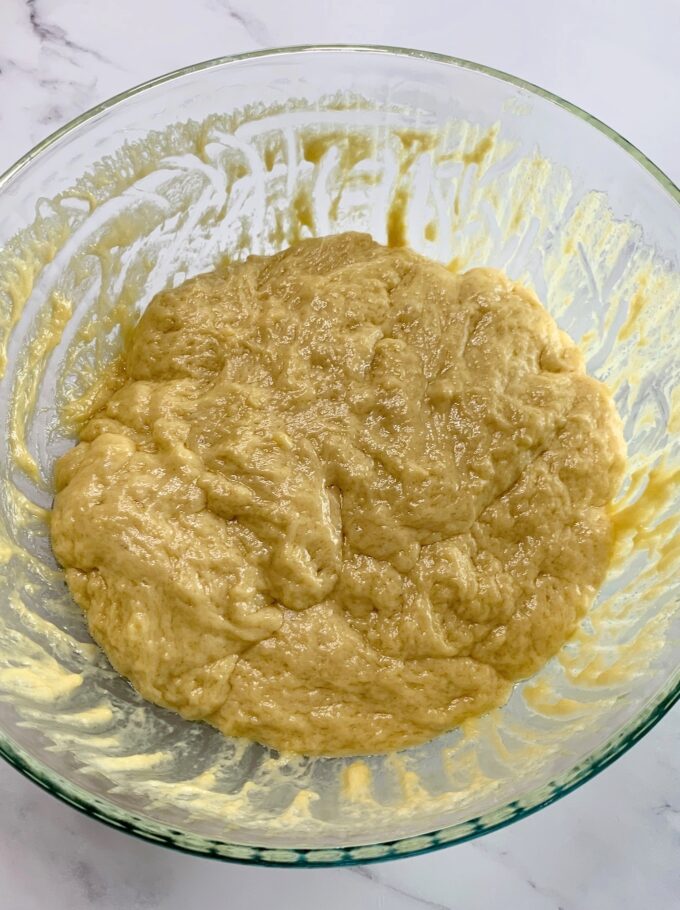
DAY ONE IS COMPLETE! See that wasn’t hard!!

Day Two – forming rolls, second rise, and baking!
- Make the egg wash: Whisk together the egg and water. Set aside.
- Roll out and divide the dough: Generously butter 2 loaf pans that measure 8 1/2 by 4 1/2 inches on the tops and 7 1/2 by 3 1/2 inches on the bottoms.
- Using a bench scraper, divide the dough into 2 equal pieces on a lightly floured work surface.
- Roll into balls: Divide each piece into 8 equal pieces. Form each piece into a ball.
- Arrange 8 balls side by side in each loaf pan. Cover the pans with lightly sprayed or buttered plastic wrap (buttered side down) and place in a warm place (or oven) until the dough has risen to about 1-inch above the top of the pans.
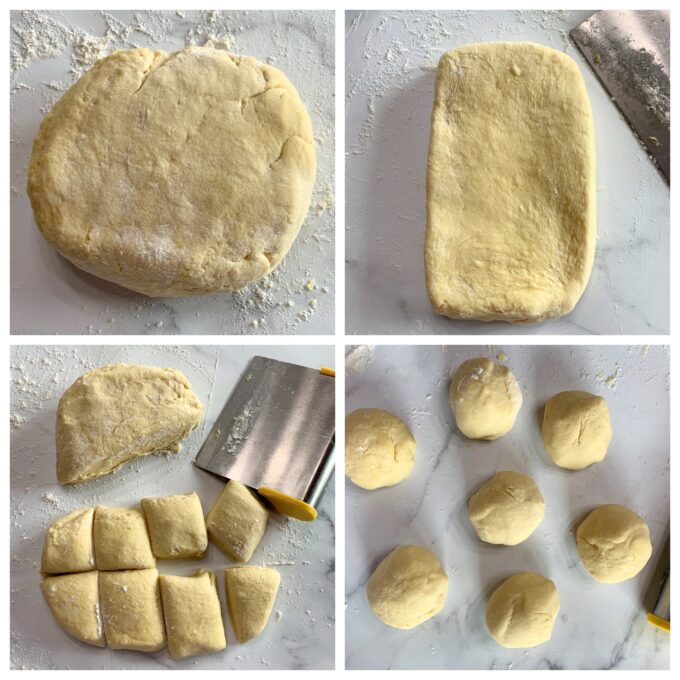
- Arrange the balls in pans and let rise: Arrange 8 balls side by side in each loaf pan. Cover the pans with lightly sprayed or buttered plastic wrap (buttered side down) and place in a warm place (or oven) until the dough has risen to about 1-inch above the top of the pans.
- Preheat an oven to 425 degrees.
- Very lightly, brush the tops of the rolls with the egg wash. This is optional but makes for a shiny top crust. If you brush too much egg wash onto the tops, it can cause excess browning.
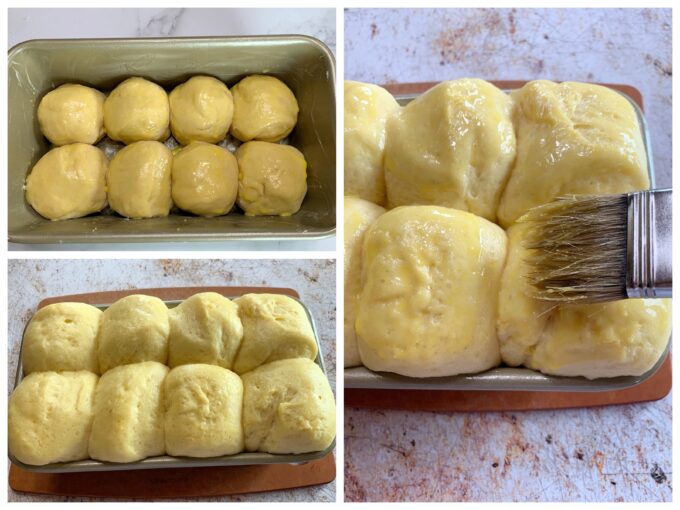
- Bake the bread: Bake the bread for about 15 minutes, until it’s just beginning to turn a light golden color on top.
- Reduce the heat to 375 degrees, and bake for approximately 20 to 25 minutes, until the bread is a deep golden brown or an internal temperature of 205 degrees. It’s important to not underbake this bread. Note: If the bread seems to be browning too quickly on top, place a foil tent over it.
- Remove the bread from the oven and allow it to cool for 5 minutes in the pans. Remove the bread from the pans and allow it to cool completely. Use a serrated knife and cut the bread into 1/2-inch slices.
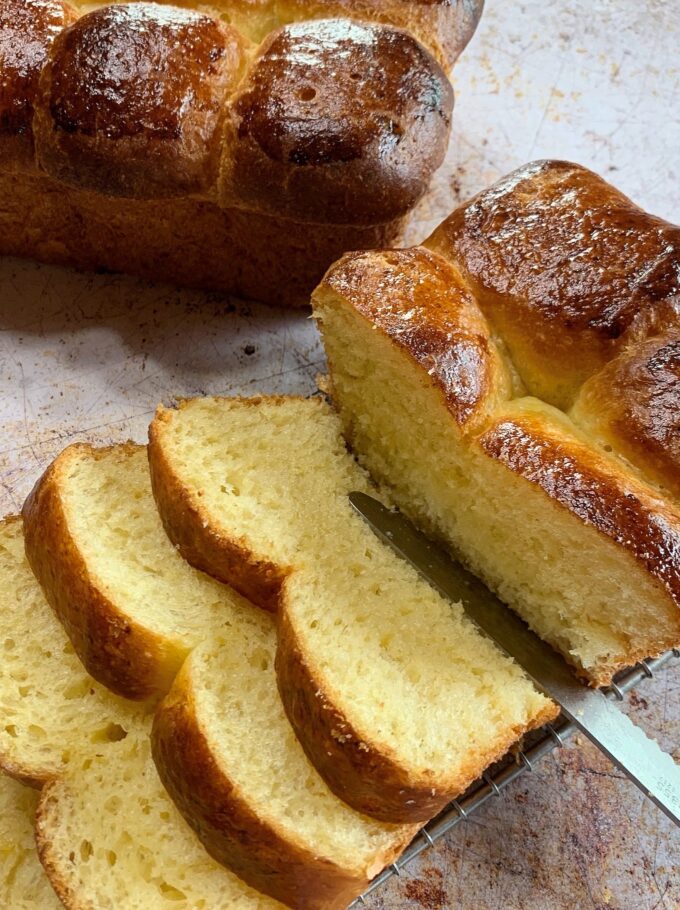

Once you see how easy it is to bake with yeast you might want to try these other yeast recipes…
Classic Sweet Dough Cinnamon Rolls
Honey Rolls with Cinnamon Honey Butter
If you make this recipe please rate it, and leave a comment below on how you liked it. I love getting your feedback. 🙂
Wanna see new recipes each day? Feel free to follow me on Facebook, Pinterest, & Instagram.
Print
Brioche Bread
- Prep Time: 30 minutes
- Cook Time: 35 minutes
- Total Time: 1 hour 5 minutes
- Yield: 2 loaves 1x
- Category: Bread
- Method: Bake
- Cuisine: French
Description
This Brioche Bread is rich, buttery, and eggy and the perfect bread for French toast or bread pudding recipes. It makes two loaves so freeze one for later.
Ingredients
DOUGH
- 1 packet (.25 ounces) active dry yeast (about 2 1/4 teaspoons)*
- 5 tablespoons lukewarm milk at 100 to 110 degrees
- 6 large eggs, room temperature
- 3 1/2 cups all-purpose flour, spooned & leveled (1 pound 2 ounces, if weighing), plus more for work surface
- 1 teaspoon salt
- 1 1/2 cups (3 sticks) unsalted butter slightly softened, not quite at room temperature
- 1/4 cup granulated sugar
EGG WASH
- 1 large egg yolk
- 1 tablespoon milk
Instructions
DAY ONE
- Preheat oven to 160 degrees and turn off. Slightly crack the oven door. Generously butter a large bowl and set aside.
- Proof the yeast: In a measuring cup, add the yeast to the lukewarm milk and let proof for 5 minutes. I use a spoon to push the dry yeast down into the milk so that all of it gets wet. Set this aside while starting the next step.
- Add the eggs to the bowl of a stand mixer fitted with the dough hook. Mix the eggs for a few seconds to break them up. Add the flour, salt, and yeast mixture. Mix on low speed for 5 minutes to combine and start kneading. Turn mixer to medium speed and continue to knead until the dough is smooth and elastice, about 10 minutes.
- In a separate bowl, mix the sugar into the butter, combining well. Drop a few pieces of the butter mixture into the bowl, while mixing on low speed. Continue adding the butter mixture a little bit at a time, mixing on low speed until all of the butter has been incorporated. Don’t drop too much butter in at a time. It takes a little while for the butter (fat) to be incorporated into the flour & egg.
- Once the butter is totally incorporated, increase the mixer to medium speed and knead the dough for about 6 to 8 more minutes. The dough should be shiny, smooth, and elastic, and it should easily pull away from the sides of the bowl. It will also be pretty thin, almost like pancake batter. See the picture in the post above.
- Using a spatula, transfer the dough to the prepared (buttered) bowl. Lightly spray a piece of plastic wrap and place over the top, sealing it tightly.
- Place the bowl in the slightly warm oven, leaving the door ajar, until the dough is doubled in size, about 2 hours. I preheated my oven to 160 degrees before starting this recipe, turned it off, and slightly cracked the oven door. Alternately, you can place the bowl in a warm area in your kitchen that’s free from drafts.
- Remove the dough from the oven and uncover it. Lift the dough up in the air from the bowl and drop it back into the bowl. Do this twice more. This deflates the dough. Cover the bowl with plastic wrap again and place the bowl in a refrigerator to chill for at least 8 hours or overnight.
DAY TWO
- Make the egg wash: Whisk together the egg and water. Set aside.
- Generously butter 2 loaf pans that measure 8 1/2 by 4 1/2 inches on the tops and 7 1/2 by 3 1/2 inches on the bottoms. Using a bench scraper, divide the dough into 2 equal pieces on a lightly floured work surface. Divide each piece into 8 equal pieces. Form each piece into a ball. Arrange 8 balls side by side in each loaf pan. Cover the pans with lightly sprayed or buttered plastic wrap (buttered side down) and place in a warm place (or oven) until the dough has risen to about 1-inch above the top of the pans. Uncover the pans and lightly brush the tops with the egg wash.
- Preheat conventional oven to 425 degrees. **see notes below for convection oven.
- Bake the bread for about 15 minutes, until it’s just beginning to turn golden on top. Reduce the heat to 375 degrees, and bake for approximately 20 to 25 minutes, until the bread is a deep golden brown or an internal temperature of 205 degrees. It’s important to not underbake this bread. Note: If the bread seems to be browning too quickly on top, place a foil tent over it.
- Remove the bread from the oven and allow it to cool for 5 minutes in the pans. Remove the bread from the pans and allow to cool completely. Use a serrated knife and cut the bread into 1/2-inch slices.
- This bread is best if eaten the day it’s made. Use the leftover bread to make french toast. It makes excellent french toast. You can also freeze slices to use in french toast later.
Notes
- *If using fresh yeast, use 1/2 ounce.
- **If using a convection oven, preheat the oven to 400 degrees. Bake the bread for 15 minutes. Reduce oven to 350 degrees and bake for approximately and bake until deep golden brown on top, about 20 to 25 minutes, or an internal temperature of 205 degrees.
